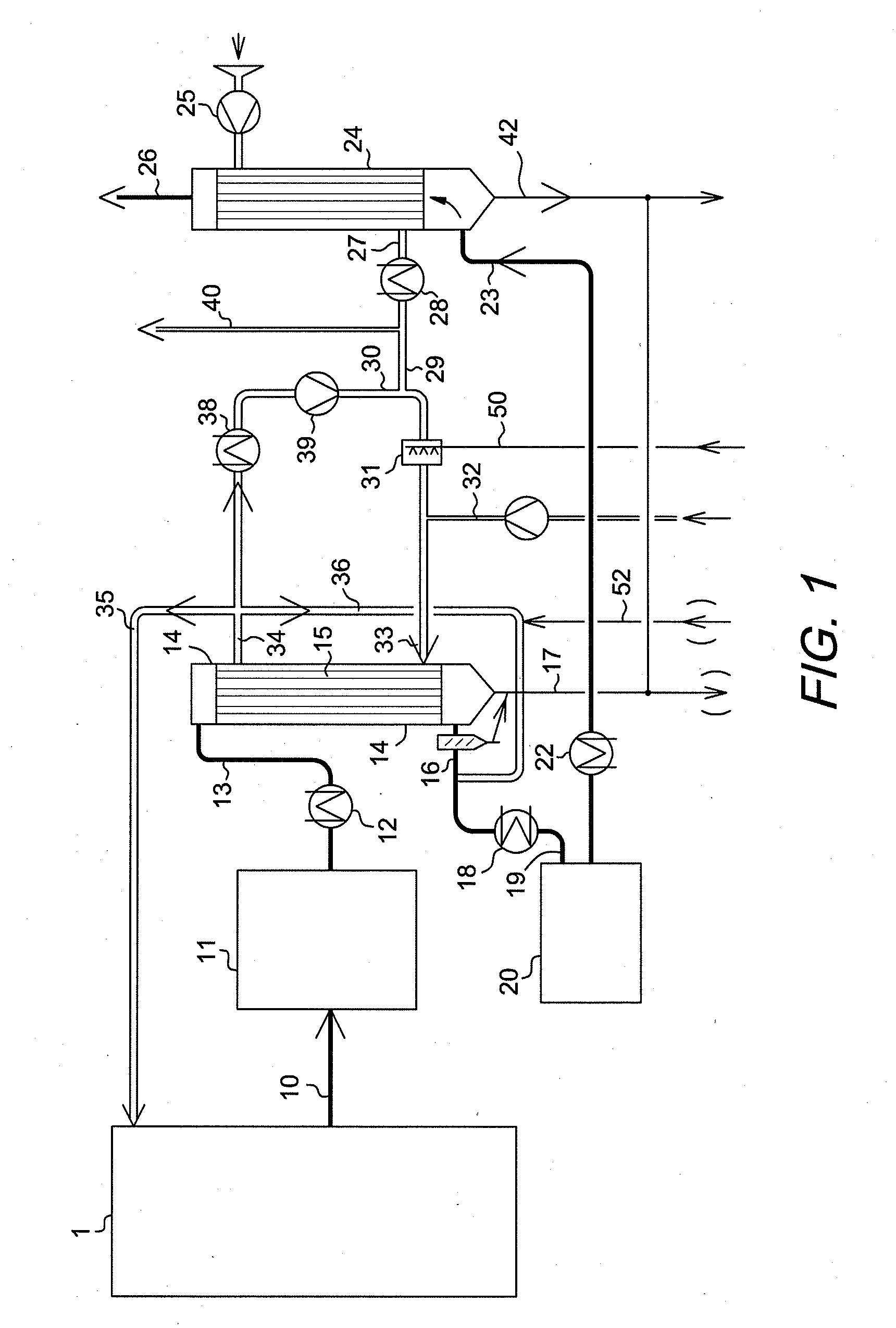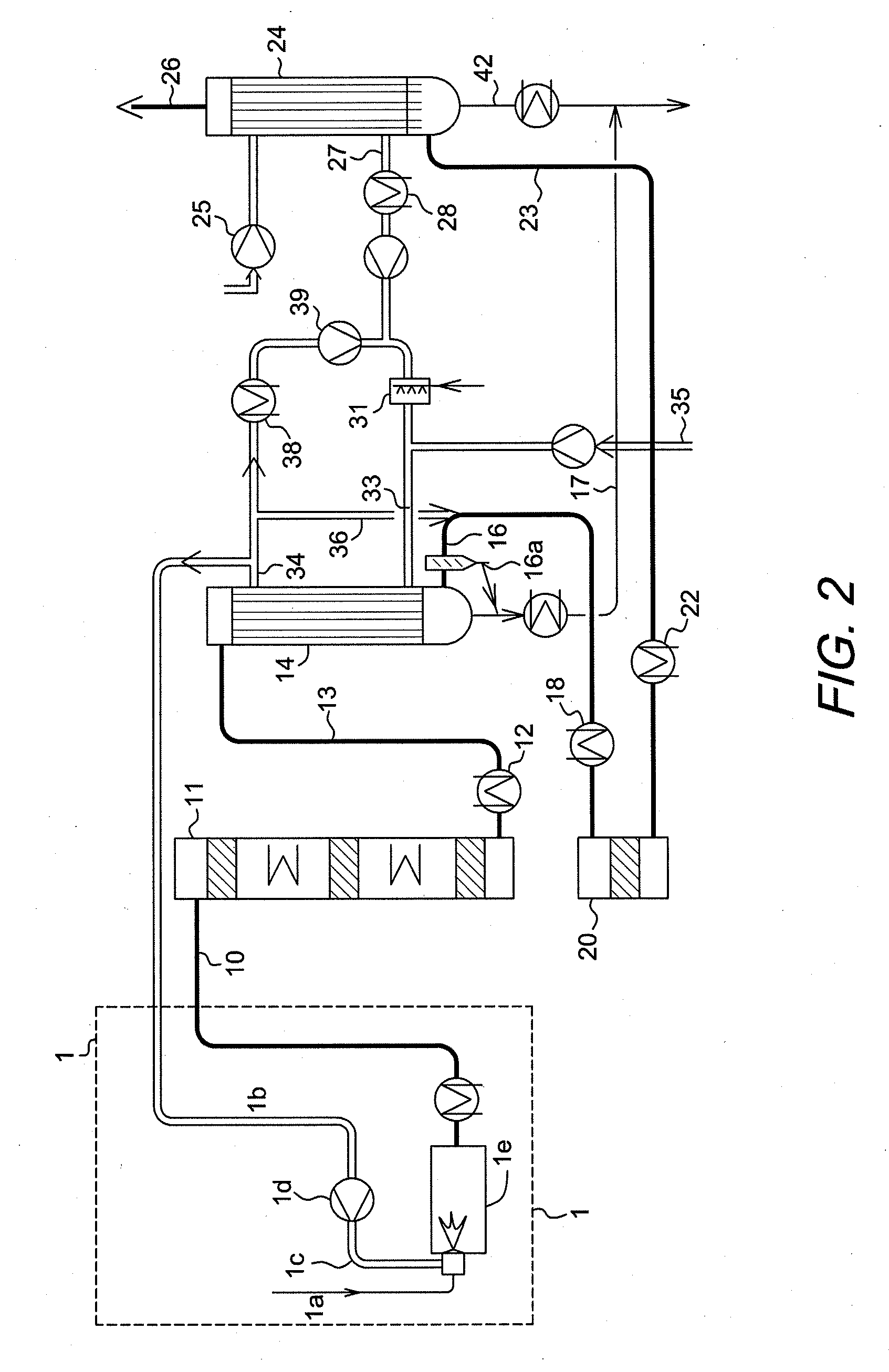Process for the production of sulphuric acid
a technology of sulphuric acid and oleum, which is applied in the direction of sulfur-trioxide/sulfuric acid, chemistry apparatus and processes, inorganic chemistry, etc., can solve the problems of large amount of heat liberated in the absorption or condensation towers usually lost to cooling water, and the applicability of this system is strongly limited, so as to reduce costs and cost
- Summary
- Abstract
- Description
- Claims
- Application Information
AI Technical Summary
Benefits of technology
Problems solved by technology
Method used
Image
Examples
example 1
[0058]FIG. 2 shows the process of the invention applied for production of 31 t / h of 98.5% H2SO4 from combustion of 10 ton / h of sulphur with 62,000 Nm3 / h air with 11.8% H2O giving 11.3% SO2+11.8% H2O in the feed gas in line 10. The marked region 1 represents the feed gas production section. The total SO2-conversion is >99.9%. In the first step of the process, 96.31% of the SO2 is converted to SO3 practically all of which is withdrawn as 98.5% H2SO4 from the intermediate condenser. Ψ is chosen to 1.086 yielding 98.5% H2SO4 as the condensate from the intermediate condenser in which the gas is cooled to 150° C. (T16 in line 16). If Ψ is decreased to, say, 1.05, the strength of the condensed acid increases to 99.0%, as seen in Table 1. Possible carry over to the second step of the process of about 1000 ppm H2SO4 mist not being removed in the droplet arrester 16a seen in line 16 does not change the operating data significantly and would have only the effect that 200 kg / h 98.5% H2SO4 would...
example 2
[0063]FIG. 3 shows the process of the invention embodied for production of oleum from combustion of the same amount of sulphur and oxygen as in Example 1, and with slight lower SO2-conversion in the first SO2 conversion step (due to a lower content of H2O in the gas). The amount of water evaporated in 31 is reduced from 6028 kg / h in Example 1 to 2871 kg / h water in order to obtain Ψ=0.659 which means that 65.9% of the SO3 in the gas is converted to H2SO4 practically all of which will be condensed at 140° C. However, substantial absorption of the SO3 in the condensed H2SO4 requires much lower temperatures. Hence, the gas and the condensed H2SO4 is further cooled to 40° C. in order to absorb 80% of the free SO3 in the H2SO4 yielding oleum with 24.5-25 wt % SO3 being withdrawn from the intermediate condenser. This cooling is best achieved in two steps as seen in FIG. 3:[0064]First, all H2SO4 is condensed and the gas is cooled to about 100° C. in the air cooled glass tubes. In order to o...
example 3
[0069]This example concerns the treatment of gas streams from wet scrubbing with up 70 vol % SO2. Such gas streams originate from metallurgical roasting processes or from thermal regeneration of spent sulphuric acid or sulphates and are purified by wet scrubbing before being fed to any process for production of sulphuric acid.
[0070]FIG. 4 shows the process of the invention for treatment of an original gas stream of 20,507 Nm3 / h in line 2 entering the feed gas production section 1 with 34.09% SO2, 1.42% O2 and 7.66% H2O (saturated at 40° C., −50 mbar, equivalent t 1000 kg / h sulphur) of scrubbed SO2 gas from oxygen enriched roasting of metal sulphides. The gas, which corresponds to 10,000 kg sulphur / h, is mixed with line 35 containing 25,482 Nm3 / h hot air with 21.38% H2O withdrawn from the air recycling loop of the intermediate condenser comprising the amount O2 and H2O required for the first SO2 conversion step of the process. After heating the gas stream to 400° C. with superheated ...
PUM
 Login to View More
Login to View More Abstract
Description
Claims
Application Information
 Login to View More
Login to View More - R&D
- Intellectual Property
- Life Sciences
- Materials
- Tech Scout
- Unparalleled Data Quality
- Higher Quality Content
- 60% Fewer Hallucinations
Browse by: Latest US Patents, China's latest patents, Technical Efficacy Thesaurus, Application Domain, Technology Topic, Popular Technical Reports.
© 2025 PatSnap. All rights reserved.Legal|Privacy policy|Modern Slavery Act Transparency Statement|Sitemap|About US| Contact US: help@patsnap.com



